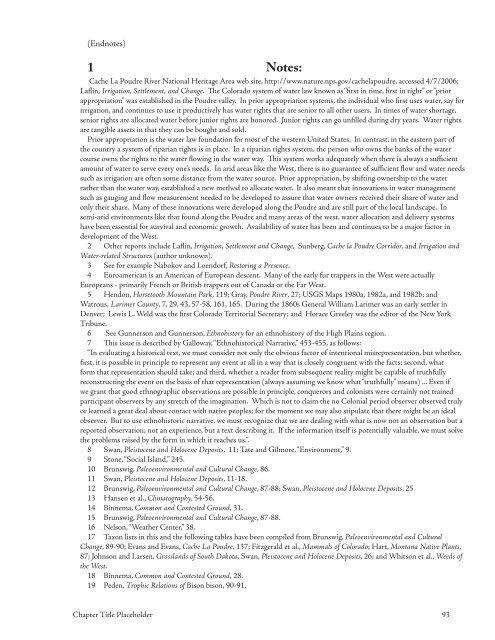People of the Poudre - Cache la Poudre National Heritage Area
People of the Poudre - Cache la Poudre National Heritage Area
People of the Poudre - Cache la Poudre National Heritage Area
You also want an ePaper? Increase the reach of your titles
YUMPU automatically turns print PDFs into web optimized ePapers that Google loves.
(Endnotes)1 Notes:<strong>Cache</strong> La <strong>Poudre</strong> River <strong>National</strong> <strong>Heritage</strong> <strong>Area</strong> web site, http://www.nature.nps.gov/cache<strong>la</strong>poudre, accessed 4/7/2006;Laflin, Irrigation, Settlement, and Change. The Colorado system <strong>of</strong> water <strong>la</strong>w known as “first in time, first in right” or “priorappropriation” was established in <strong>the</strong> <strong>Poudre</strong> valley. In prior appropriation systems, <strong>the</strong> individual who first uses water, say forirrigation, and continues to use it productively has water rights that are senior to all o<strong>the</strong>r users. In times <strong>of</strong> water shortage,senior rights are allocated water before junior rights are honored. Junior rights can go unfilled during dry years. Water rightsare tangible assets in that <strong>the</strong>y can be bought and sold.Prior appropriation is <strong>the</strong> water <strong>la</strong>w foundation for most <strong>of</strong> <strong>the</strong> western United States. In contrast, in <strong>the</strong> eastern part <strong>of</strong><strong>the</strong> country a system <strong>of</strong> riparian rights is in p<strong>la</strong>ce. In a riparian rights system, <strong>the</strong> person who owns <strong>the</strong> banks <strong>of</strong> <strong>the</strong> watercourse owns <strong>the</strong> rights to <strong>the</strong> water flowing in <strong>the</strong> water way. This system works adequately when <strong>the</strong>re is always a sufficientamount <strong>of</strong> water to serve every one’s needs. In arid areas like <strong>the</strong> West, <strong>the</strong>re is no guarantee <strong>of</strong> sufficient flow and water needssuch as irrigation are <strong>of</strong>ten some distance from <strong>the</strong> water source. Prior appropriation, by shifting ownership to <strong>the</strong> waterra<strong>the</strong>r than <strong>the</strong> water way, established a new method to allocate water. It also meant that innovations in water managementsuch as gauging and flow measurement needed to be developed to assure that water owners received <strong>the</strong>ir share <strong>of</strong> water andonly <strong>the</strong>ir share. Many <strong>of</strong> <strong>the</strong>se innovations were developed along <strong>the</strong> <strong>Poudre</strong> and are still part <strong>of</strong> <strong>the</strong> local <strong>la</strong>ndscape. Insemi-arid environments like that found along <strong>the</strong> <strong>Poudre</strong> and many areas <strong>of</strong> <strong>the</strong> west, water allocation and delivery systemshave been essential for survival and economic growth. Avai<strong>la</strong>bility <strong>of</strong> water has been and continues to be a major factor indevelopment <strong>of</strong> <strong>the</strong> West.2 O<strong>the</strong>r reports include Laflin, Irrigation, Settlement and Change, Sunberg, <strong>Cache</strong> <strong>la</strong> <strong>Poudre</strong> Corridor, and Irrigation andWater-re<strong>la</strong>ted Structures (author unknown).3 See for example Nabokov and Loendorf, Restoring a Presence.4 Euroamerican is an American <strong>of</strong> European descent. Many <strong>of</strong> <strong>the</strong> early fur trappers in <strong>the</strong> West were actuallyEuropeans - primarily French or British trappers out <strong>of</strong> Canada or <strong>the</strong> Far West.5 Hendon, Horsetooth Mountain Park, 119; Gray, <strong>Poudre</strong> River, 27; USGS Maps 1980a, 1982a, and 1982b; andWatrous, Larimer County, 7, 29, 43, 57-58, 161, 165. During <strong>the</strong> 1860s General William Larimer was an early settler inDenver; Lewis L. Weld was <strong>the</strong> first Colorado Territorial Secretary; and Horace Greeley was <strong>the</strong> editor <strong>of</strong> <strong>the</strong> New YorkTribune.6 See Gunnerson and Gunnerson, Ethnohistory for an ethnohistory <strong>of</strong> <strong>the</strong> High P<strong>la</strong>ins region.7 This issue is described by Galloway, “Ethnohistorical Narrative,” 453-455, as follows:“In evaluating a historical text, we must consider not only <strong>the</strong> obvious factor <strong>of</strong> intentional misrepresentation, but whe<strong>the</strong>r,first, it is possible in principle to represent any event at all in a way that is closely congruent with <strong>the</strong> facts; second, whatform that representation should take; and third, whe<strong>the</strong>r a reader from subsequent reality might be capable <strong>of</strong> truthfullyreconstructing <strong>the</strong> event on <strong>the</strong> basis <strong>of</strong> that representation (always assuming we know what “truthfully” means) ... Even ifwe grant that good ethnographic observations are possible in principle, conquerors and colonists were certainly not trainedparticipant observers by any stretch <strong>of</strong> <strong>the</strong> imagination. Which is not to c<strong>la</strong>im <strong>the</strong> no Colonial period observer observed trulyor learned a great deal about contact with native peoples; for <strong>the</strong> moment we may also stipu<strong>la</strong>te that <strong>the</strong>re might be an idealobserver. But to use ethnohistoric narrative, we must recognize that we are dealing with what is now not an observation but areported observation; not an experience, but a text describing it. If <strong>the</strong> information itself is potentially valuable, we must solve<strong>the</strong> problems raised by <strong>the</strong> form in which it reaches us.”.8 Swan, Pleistocene and Holocene Deposits, 11; Tate and Gilmore, “Environment,” 9.9 Stone, “Social Is<strong>la</strong>nd,” 245.10 Brunswig, Paleoenvironmental and Cultural Change, 86.11 Swan, Pleistocene and Holocene Deposits, 11-18.12 Brunswig, Paleoenvironmental and Cultural Change, 87-88; Swan, Pleistocene and Holocene Deposits, 2513 Hansen et al., Climatography, 54-56.14 Binnema, Common and Contested Ground, 31.15 Brunswig, Paleoenvironmental and Cultural Change, 87-88.16 Nelson, “Wea<strong>the</strong>r Center,” 38.17 Taxon lists in this and <strong>the</strong> following tables have been compiled from Brunswig, Paleoenvironmental and CulturalChange, 89-90; Evans and Evans, <strong>Cache</strong> La <strong>Poudre</strong>, 137; Fitzgerald et al., Mammals <strong>of</strong> Colorado; Hart, Montana Native P<strong>la</strong>nts,87; Johnson and Larsen, Grass<strong>la</strong>nds <strong>of</strong> South Dakota, Swan, Pleistocene and Holocene Deposits, 26; and Whitson et al., Weeds <strong>of</strong><strong>the</strong> West.18 Binnema, Common and Contested Ground, 28.19 Peden, Trophic Re<strong>la</strong>tions <strong>of</strong> Bison bison, 90-91.Chapter Title P<strong>la</strong>ceholder 93


